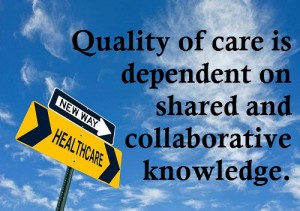The implementation of automated and time efficient methodologies in healthcare information processing can expedite and enhance streamlining of patient management and quality of care. While maintaining quality of care, an essential concept to address is defining the boundaries between efficiency in automation and maintaining a foundational understanding of core medical concepts. As technological advancements are increasingly integrated in the healthcare delivery model, organizations and providers should maintain the foundation that quality of care remains dependent on shared and collaborative knowledge. The advent of technological efficiency should not replace or supersede fundamental medical dialogue and comprehension required for thorough patient management.
 Software applications and data processing systems will be able to capture and process treatment diagnoses and procedural coding in a systematic manner. However, the gaps that need to be addressed occur when there is a need to have communication among peers that extends beyond the capabilities of information systems processing. Possible reasons include clarification of discrepancies, update on procedures and medical interventions, and patient case specific treatment and management. Therefore, it follows that the implementation of information systems should include allowances and methods to recognize and assess any gaps of information. A method that defines parameters and thresholds of potential gaps, aligning gap analyses with appropriate provider/payer/government reviewers, and determining objectives based on findings. An overall integration that is inclusive of information systems processes and inherent gaps will provide a comprehensive implementation of healthcare delivery systems.
Software applications and data processing systems will be able to capture and process treatment diagnoses and procedural coding in a systematic manner. However, the gaps that need to be addressed occur when there is a need to have communication among peers that extends beyond the capabilities of information systems processing. Possible reasons include clarification of discrepancies, update on procedures and medical interventions, and patient case specific treatment and management. Therefore, it follows that the implementation of information systems should include allowances and methods to recognize and assess any gaps of information. A method that defines parameters and thresholds of potential gaps, aligning gap analyses with appropriate provider/payer/government reviewers, and determining objectives based on findings. An overall integration that is inclusive of information systems processes and inherent gaps will provide a comprehensive implementation of healthcare delivery systems.
